What is Pad Printing? – Different Types of Pad Printing Machines, Inks, Printing Pads, Printing Plates and Techniques
What is Pad Printing?
Pad printing is an indirect photogravure process to transfer a 2D image upon a 3D object. Depressions are etched into a flat plate. These depressions are filled with ink and a smooth silicone pad (silicone is ink repellent) is used to pick up some ink on the plate and transfers it to the object. This stamp is called pad and gave this printing process its name. Pad Printing is used for printing on difficult-to-print on products in many industries including automotive, medical, apparel, and electronic objects, as well as electronic appliances, toys and sports equipment. Pad printing is very versatile. Many objects can be printed with little effort. Thanks to consequent further and new developments in the field of consumables as inks, pads and plates continuously new application possibilities are found. At the same time technical innovations provide better solutions. Camera systems are increasingly used. Depending on the requirements and applications the position of the object in the jig and/or the printed image itself is checked. If required an automatic correction of the print can be configured, if for instance the printing position is not exact. Especially with high quality objects the use of cameras is useful to avoid the cost of misprints.
Pad printing is very versatile. Many objects can be printed with little effort. Thanks to consequent further and new developments in the field of consumables as inks, pads and plates continuously new application possibilities are found. At the same time technical innovations provide better solutions. Camera systems are increasingly used. Depending on the requirements and applications the position of the object in the jig and/or the printed image itself is checked. If required an automatic correction of the print can be configured, if for instance the printing position is not exact. Especially with high quality objects the use of cameras is useful to avoid the cost of misprints.
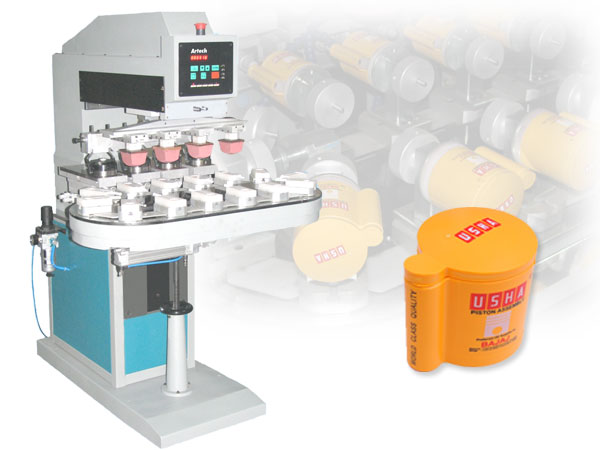

The pad printing process has undergone a rapid development in the past 40 years and is now one of the most important printing processes. The use of silicone rubber was instrumental in bringing about its success as a print medium (pad) because it allows easy deforming, it is ink repellent and as a result ensures an excellent ink transfer. Pad printing enables printing on uneven surfaces. The printed images vary from simple markings to multicolored photo prints. The pad printing process is flexible and versatile. To meet the demands of the market pad printing continually rises to new challenges. What started out as a method to print simple marks and inscriptions now goes beyond to the artistic decoration prints. The range of pad printing starts with functional markings such as on measuring cups or on switch buttons, and has been supplemented in the past years by an important factor: the product should look “Pretty” because today, look and design are significant factors that contribute to the sales success.
Distinction between Pad Printing and Other Conventional Methods of Printing:
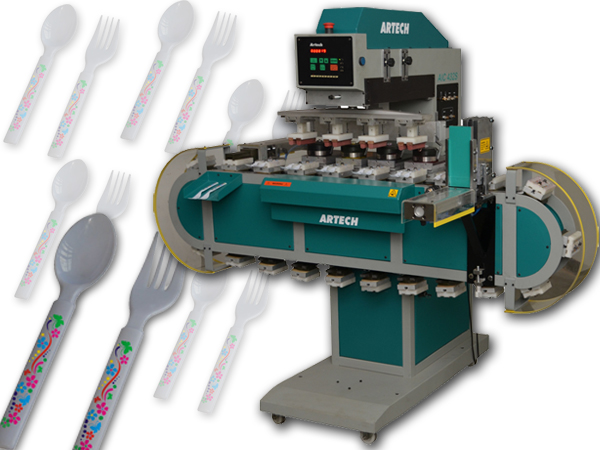
Every printing method such as pad printing, digital printing, screen printing and hot stamping has its pros and cons that define if it is suitable or not for a specific application. The printing methods might compete in certain areas, but usually the advantages complement each other and offer the user the ideal solution for every application. The special brilliance of gold and silver foils cannot be achieved in any other way than with hot stamping, but in return screen printing offers ink coverage across large areas. Best Pad printing has its strength in printing uneven surfaces among other things.
Plate and ink interface technologies
Open inkwell system
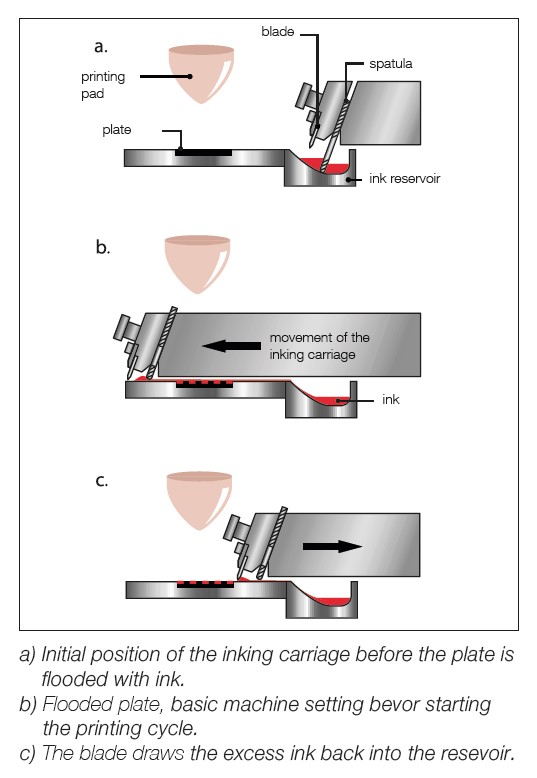
Open ink well systems, the older method of pad printing, used an ink-trough for the ink supply, which was located behind the printing plate. A flood bar pushed a pool of ink over the plate, and a doctor-blade removes the ink from the plate surface, leaving ink on the etched artwork area ready for the pad to pick up.
Sealed ink cup system
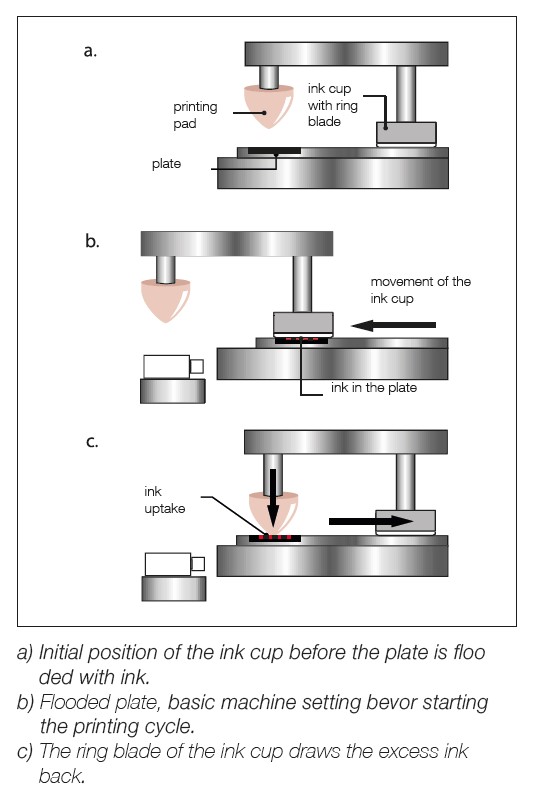
Sealed Ink Cup systems employ a sealed container which acts as the ink supply, flood bar and doctor blade all at the same time. A ceramic ring with a highly polished working edge provides the seal against the printing plate.
How Ink is Transferred?
When a printing cycle with an open ink well system is triggered, the ink that is lying on the plate is drawn back into the ink reservoir by a blade. In a sealed ink cup system the ink cup glides from its position over the printing image. The ring blade takes off the excess ink in the process. The ink only remains in the depressions of the plate.

The thinner in the ink evaporates, causing the ink to become sticky. The pad is then lowered onto the plates surface and the ink is transferred from the plate to the pad. The ink on the pad is then transferred to the to be printed surface. When being applied the ink detaches from the pad and stays on the object.
Ink Pick-Up and Ink Transfer
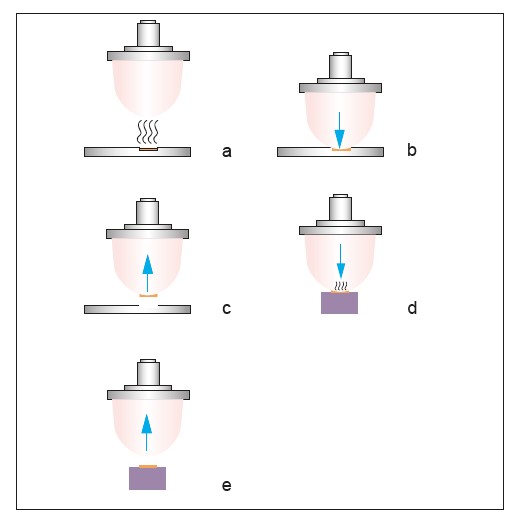
The following illustration shows the ink transfer process. Printing pads are used as a transfer medium. They pick up the ink from the plate and apply it to the object.
Ink Layer Thickness
The thickness of the ink layer that is transferred in pad printing is approximately 4 to 10 microns. The ink›s thickness depends on the type of ink, the ink tone, the ink viscosity, the pad material, the etch depth of the plate and the atmospheric conditions such as heat, humidity etc.
Multi-colour printing
Thanks to the thin ink layer that is transferred in pad printing, it is possible to carry out a multi-color print «wet in wet», without drying in-between. For this we offer different peripheral devices for example:
Pad sliding devices for two color printing
Rotary tables
Shuttle tables
Transfer Carrés
Incremental launch
Printing Pads
Printing pads play a significant role in pad printing: It is one of the deciding factors for producing excellent print results. Teca-Print manufactures high-quality printing pads tailored to the needs of pad printers and backed by a qualified team for support. With a commitment to excellence, silicon grade and pad shapes are continuously evaluated and improved. Printing pads are made of silicone and are available in different qualities, forms and hardness.
Pad families, silicon types and hardnesses (i.e. durometer)
The ink transfer performance varies depending on the properties of the silicon. There is a wide range of silicon types to choose from in order to find the ideal pad for each application and to optimize the print quality.
The hardness of the pads are measured in Shore. Teca-Print uses the scale according to the system 00 Si. The production tolerance is ± 2 Shore 00 Si. Generally speaking, pad durometers range from 39 Shore 00 Si (very soft) to 70 Shore 00 Si (very hard). In addition to the quality of the surface and shape of the part to be printed, the printing force of the machine and the size of the printing image must also be taken into consideration when choosing the proper pad durometer.
Pad Printing Plates
Printing Cliche Plates plays an important role in pad printing as it holds the printing image that is transferred by the pad to the object. The quality of the plate and the printing image affect the quality of the print directly. Plate types that are suitable for pad printing:
Plastic plates
Steel plates
Steel plates 05
Ceramic plates
Within the different plate types there are many further divisions, so that there is a suitable plate for each application and machine fitting. Apart from ceramic plates that are lasered, printing images are etched into the photo sensitive layer on the surface of all the other plate types. A film with the image is placed on the plate and exposed under UV-light. The parts that were covered by the image stay soft. Depending on the plate type the soft parts are washed out or etched.
About Us :-
Artech Pad Printing Industries – One of the Largest and Oldest Pad Printing Machines Manufacturer and Supplier in India. Exceptional Quality and Cheap Pad Printing services available. Our Pad Printing Machines are available throughout India. Buy the Best Pad Printing Machines from the Best and Cheapest Pad Printer in India.
